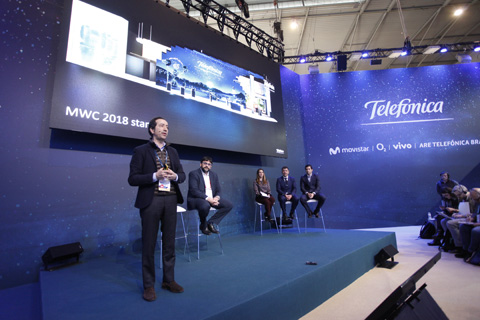The 4.0 Industry initiative applies in the automotive industry
- Telefónica introduces a proposal to promote changes in production systems in every sector of the industry.
- Specifically, they have schematically reproduced the phases of a manufacturing process in the automotive sector and how new technologies can attribute to their optimisation.
Barcelona, 28 February 2018.- Today, Telefónica has presented possibilities for digitalisation of industry with its Industry 4.0 initiative, demonstrating the benefits of the use of new technologies in industrial processes and in particular in the automotive industry.
Thereby, Telefónica demonstrates how the whole process of manufacture, receipt and distribution in the automotive sector can be transformed using new technology. This will allow improvements in traceability, process and decision-making automation and information immutability, it is an advantage of the distinct stakeholders in the chain as well as the end customer.
To achieve this, the technological components integrated into this industrial supply chain ecosystem recreated for the Mobile World Congress, they are the Internet of things (IoT), the blockchain, advanced connectivity (5G and private LTE) technologies and augmented reality.
“Today, practically all industries and sectors rely on new technologies to improve their processes. The purpose is to be more efficient and secure and even to improve forecasting of business needs. The industrial sector has specific security, real time decision-making and service quality requirements to which the connectivity of objects is learning to respond, using the IoT, the evolution of cellular networks and new processes, such as the blockchain. Our challenge as a company is to change people’s lives, and in this case, to help businesses become more efficient, assisting them in taking decisions based on data and digitalising their processes to make them more efficient. This is the commitment that Telefónica have assumed,” says Vicente Muñoz, Telefónica’s Chief IoT Officer.
In this representation of an Industry 4.0 scenario, Telefónica shows the initial results of the co-innovation project it is working on with SEAT and in wich Ficosa participates. Specifically, it represents how the use of blockchain technology can provide information traceability, transparency and veracity in the supply chain, from the providers’ supply of pieces (for example, rear-view mirrors manufactured by Ficosa in Soria) through to the purchase of the SEAT vehicle by the end consumer of various countries.
The first part of the demonstration shows the delivery of parts throughout the supply chain, assembly of a vehicle and its delivery to the end customer, as well as other events occurring during the process. Also, it is presented in this phase is the blockchain technology. Both to guarantee the information traceability, transparency and veracity from the supply of parts by the providers to the purchase of the vehicle by the final consumer, and to record all the related events, some of which are automatically detected via IoT sensors.
Telefónica uses IoT sensorisation in the case of use with SEAT and FICOSA, shown in the MWC, with the aim of knowing the status of the assets during transport. Other additional capabilities have also been implemented, such as the automatic writing of events in the block chain, document management and smart contracts, which are automatically implemented according to the events recorded at the various points of the supply chain. The distinct participants have private, secure access to blockchain information, with different visualisation depending on the permits and functions each of them have. Many of these events and capabilities are recreated in a virtual and gamified manner in this first part of the demonstration in order to introduce visitors to the whole process and related technologies.
The second part of the Industry 4.0 demonstration focuses on the assembly process, in which a Robotplus robotic arm, connected via private LTE through a 5G network, is activated by installing a vehicle which includes the transported component up to this point in a synchronised manner. In this phase, Telefónica shows how the new concept of network slicing, one of the great assets of 5G technology, permits the offering of new digital services to industry, providing the possibility of simultaneously delivering distinct network capabilities to different types services using a common infrastructure. In this way, 5G guarantees that critical processes in the production chain, such as control of industrial robots or high precision tasks, it has excellent wireless connectivity and minimum latency.
It also is important at this point to highlight the importance of 5G and the new IoT connectivities in industrial environments, such as (Narrow Band) NB – IoT, LTE-M and CAT1 in these fields. These technologies are equipped with advanced capabilities, which are of particular advantage to industry, such as lower battery consumption, reinforced interior coverage and support of a higher density of connected objects. Telefónica already has standard NB-IoT capabilities available in commercial networks and provides a service in this respect to many companies in the MWC.
In the final part of the demonstration, augmented reality is incorporated into the Industry 4.0 ecosystem. To perform maintenance work on the robotic arm, a factory worker may use augmented reality glasses and a video call system, it works in real time using 5G connectivity. For this, you have to connect to a remote expert who will assist to optimize the operation of the robot. This maintenance application has been developed in partnership with Ericsson.
The digital transformation of industry is a strategic priority for Telefónica. The availability of high-quality, reliable and secure communications without delays and with wireless 5G allows current industrial processes to evolve and makes them more streamlined and efficient. Complementing them with digital services based on new technologies, such as blockchain, IoT sensorisation and augmented reality wich will drive these changes in production systems in every sector of industry.
-
Vicente Muñoz, Telefónica’s Chief IoT Officer -
Vicente Muñoz, Telefónica’s Chief IoT Officer
